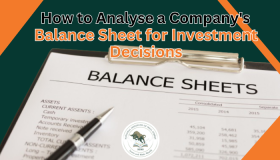31 Jul 2024
How to Analyse a Company's Balance Sheet for Investment Decisions

NIWS Toggle navigation User ImageAdmin User Image Admin Online Dashboard Master Register Details Query Career Details Franchisee Details Contact Details Blog FAQ Seo Course Course Details Gallery Placement History Edit Blog Blog Title Blog Author Blog ImageNo file chosen Blog Description
Have you ever felt lost while looking at a company’s balance sheet or other financial statements, wondering how those numbers can help you with investment decisions? Well, you’re not alone!
Here at NIWS, the leading stock market course in Jaipur, Delhi and Indore, we understand that balance sheets can seem like a confusing mix of figures and technical terms. That's why our expert traders are here to break them down for you.
What is a Balance Sheet, and How to Interpret It?
A balance sheet is a financial statement that provides a snapshot of a company's financial position at a specific point in time. It details the company's assets, liabilities, and shareholders' equity, offering a clear picture of what it owns and owes. The balance sheet is structured in a way that follows the equation:
|
Assets = Liabilities + Shareholders' Equity |
Basic analysis of a company’s balance sheet starts from understanding the components.
1. Understand the Balance Sheet Components
The balance sheet is divided into three main sections:
- Assets: What the company owns (e.g., cash, inventory, property). Assets are expected to provide future benefits, driving the company's growth and profitability.
- Liabilities: What the company owes (e.g., loans, accounts payable). Liabilities represent the funding sourced from external parties that need to be repaid.
- Equity: The net ownership value in the company (also known as shareholder equity). It includes initial capital invested by shareholders and retained earnings accumulated over time.
Now that you have an overview of the balance sheet components, the next step of the analysis is to analyse these components.
2. Analyse Assets
- Current Assets: These assets can be converted into cash within a year (e.g., cash, marketable securities, receivables, inventories). Assess the quality and liquidity of these assets.
- Non-Current Assets: These include long-term investments, property, plant and equipment (PP&E), and intangible assets. Evaluate how these assets generate revenue and consider their depreciation to understand their contribution to long-term financial health.
3. Examine Liabilities
Liabilities on a balance sheet are categorised into Current Liabilities and Long-Term Liabilities:
Current Liabilities
The company is due to settle these financial obligations within the next year, including accounts payable, short-term debt, and other accrued expenses. Analysis Tip: Assess the company's current assets about its current liabilities to gauge its ability to meet these short-term obligations. A healthy ratio indicates good liquidity, showing that the company can easily cover upcoming debts.
Long-Term Liabilities
This category includes obligations that are due beyond one year, such as long-term debt, pension liabilities, and deferred tax liabilities. Analysis Tip: Review the terms and conditions of these liabilities to understand their impact on the company’s future financial health. Analyse whether the company generates enough cash flow to comfortably manage and sustain these long-term debts without compromising its operational stability.
4. Assess Shareholder Equity
Shareholder equity on a balance sheet includes components such as common stock, retained earnings, and additional paid-in capital:
- Common Stock represents the equity invested directly by shareholders.
- Retained Earnings are the accumulated profits that have been reinvested in the business rather than distributed as dividends.
- Additional Paid-in Capital is the extra amount shareholders have paid above the nominal value of the stock.
Analysis Tip: A higher total equity typically suggests a more financially stable company. To assess the company's performance and management effectiveness, compare the growth in equity over time. Increasing shareholder equity indicates that the company is effectively generating returns and reinvesting its profits wisely, contributing to its long-term sustainability and potential for growth.
After having through details about the balance sheet components, the next step is to analyse the financial ratios. These provide a quantitive analysis of company’s financial health and operational efficiency.
5. Calculate Financial Ratios
5.1 - Liquidity Ratios
These ratios measure a company's ability to cover its short-term obligations with its current assets. They are crucial for assessing the immediate financial health of a business.
- Current Ratio: Calculated as Current Assets divided by Current Liabilities. A ratio above 1 indicates that the company has more current assets than current liabilities, suggesting good short-term financial health.
- Quick Ratio (Acid-Test Ratio): This is a more stringent test than the current ratio, calculated as (Current Assets - Inventory) divided by Current Liabilities. It excludes inventory to focus on the most liquid assets.
5.2 -Solvency Ratios
These ratios indicate a company's ability to meet its long-term debts and other financial obligations, reflecting its long-term financial stability.
-
Debt-to-Equity Ratio: Calculated as Total Liabilities divided by Shareholder Equity. A lower ratio suggests that a company is using less leverage and has a stronger equity position.
-
Debt-to-Assets Ratio: Total Liabilities divided by Total Assets. This ratio shows what proportion of a company’s assets are financed through debt.
5.3 - Profitability Ratios
These ratios help assess a company's ability to generate earnings relative to its revenue, assets, equity, and other financial metrics. They are critical for evaluating a company's earning potential.
-
Return on Assets (ROA): Net Income divided by Total Assets. This ratio measures how efficiently a company is using its assets to generate profits.
-
Return on Equity (ROE): Net Income divided by Shareholder Equity. It indicates how effectively management uses the equity shareholders invest to produce profit.
5.4 - Efficiency Ratios
These ratios assess how well a company uses its assets and liabilities internally.
-
Asset Turnover Ratio: Net Sales divided by Total Assets. This measures a company's ability to generate sales from its assets.
After completing the ratio analysis, the next is to check the red flags in company’s balance sheet, compare it with the competitors, consider external factors and trends to get detailed analysis.
6. Look for Red Flags
When analysing a company's balance sheet, be alert for indicators that could signal financial trouble:
-
High Leverage
Excessive debt is risky, particularly if a company's earnings are inconsistent. A high Debt-to-Equity Ratio indicates reliance on borrowed funds, which can be precarious during economic downturns or rising interest rates.
-
Low Liquidity
A company’s struggle to convert assets into cash suggests potential cash flow issues. Assess this through the Current Ratio and Quick Ratio; figures below industry norms are a concern, indicating difficulties in meeting short-term obligations.
-
Inconsistent Revenue from Assets
A low Asset Turnover Ratio compared to industry peers can indicate inefficiencies or overvalued assets, suggesting that the company is not effectively utilising its assets to generate revenue. This inefficiency can be a warning sign of operational challenges or poor asset management.
7. Compare with Industry Peers
To understand where a company stands about its competitors, it’s crucial to compare its financial ratios to industry averages. Here’s how you can do it:
-
Gather Industry Data: Collect financial data from other companies in the same industry. This data can typically be found in industry reports, financial databases, and analyst reports.
-
Use Benchmarking Tools: Many financial platforms provide tools for comparing a company’s performance against industry benchmarks. These tools often display averages and ranges for key ratios within an industry.
-
Analyse Trends: Look not only at static numbers but also at trends over time. How has the company’s performance changed relative to its peers? Are its ratios improving, declining, or remaining stable compared to industry averages?
-
Consider the Context: When comparing ratios, consider the size, market segment, and geographical location of other companies in the industry. A direct comparison may not always be fair; larger companies often have different financial structures than smaller ones.
-
Evaluate Outliers: If a company’s ratios significantly deviate from the industry average, try to understand why. Is it due to superior management and strategies, or do underlying issues need closer scrutiny?
-
Interpret Results: Use the comparisons to conclude the company's financial health, operational efficiency, and competitive position. Are its debt levels manageable compared to peers? Is it generating returns on assets and equity at a competitive rate?
By methodically comparing these ratios, you can gain insights into the company’s relative performance and identify potential strengths or weaknesses that may not be evident from standalone financial statements. This comparative analysis is key to making informed investment decisions.
8. Consider External Factors
External factors such as economic conditions, regulatory changes, and market trends significantly influence a company's balance sheet. For instance, economic downturns can reduce consumer spending, affecting company sales, while new regulations might increase operational costs.
Always assess how these externalities might impact the company’s assets, liabilities, and overall financial stability, helping you anticipate potential risks or opportunities.
9. Review Trends Over Time
Examine historical balance sheets to identify asset, liability, and equity trends. Positive trends, such as decreasing debt levels, increasing liquid assets, and growing equity, usually signal financial health and management effectiveness. Conversely, negative trends can indicate potential problems. This longitudinal analysis helps you understand the company’s financial trajectory and sustainability over time.
10. Synthesise Your Findings
To make informed investment decisions, integrate the balance sheet with the income and cash flow statements. The balance sheet provides a snapshot of assets, liabilities, and equity. At the same time, the income statement details profit or loss over time, and the cash flow statement shows cash movements, highlighting operational efficiency.
Analysing these statements offers a comprehensive view of the company's financial health, operational performance, and sustainability. Look for consistency or discrepancies among these statements to effectively assess financial practices and risks, leading to more strategic investment choices.
Conclusion
By simply following these easy steps, everyone, from a newbie to a seasoned investor, can easily analyse a company's balance sheet and make informed investment decisions. However, these steps are just an overview, and to get a perfect analysis of any company's balance sheet, you need to delve into more precise details, which only a course or an expert trader can help you with.
If you are looking for stock market courses in Jaipur, Delhi, or Indore, look no further than NIWS. We are a top stock market institute in India equipped with industry professionals with over 10 years of experience. We provide bookish knowledge and assist you with practical to-dos, which help with real-time learning. Connect with our experts now to know more.
